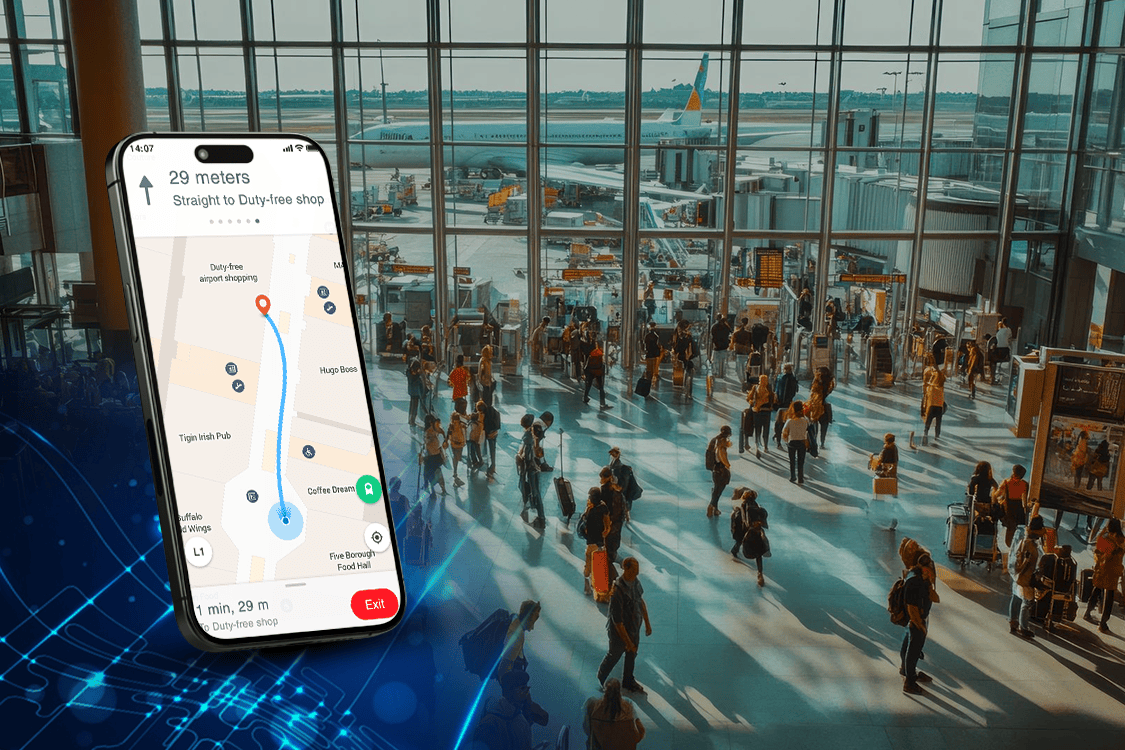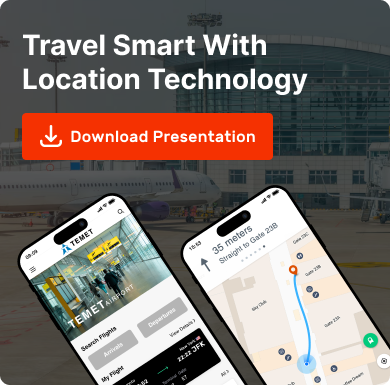Transportation Hubs

Airports are some of the busiest places on the planet. Every day, thousands of travellers move through terminals, check-in counters, security lanes and boarding gates—all in a tightly coordinated environment. But managing that much movement isn’t easy. Even a small delay in one area can ripple across the entire system. That’s where footfall traffic analysis in airports is starting to make a big difference.
Instead of relying on guesswork or outdated manual processes, airports today are using real-time data to understand exactly how passengers move through their spaces. And the results? Faster check-ins, shorter queues, better use of space and happier travellers.
North American airports experienced an 11.9% increase in overall passenger traffic in 2023 compared to 2022 and with that kind of growth, operational efficiency is no longer optional—it’s critical.


North American airports experienced an 11.9% increase in overall passenger traffic in 2023 compared to 2022 and with that kind of growth, operational efficiency is no longer optional—it’s critical.
Let’s break down how this works—and why more and more airport owners are making this a key part of their operations strategy.
What Is Footfall Traffic Analysis in Airports?
Put simply, footfall traffic analysis is about knowing where people are, how many of them are there and how they’re moving. Think of it like a heatmap for human movement. With sensors and software installed, airports can monitor patterns—when the check-in zone becomes crowded, how long passengers wait at security, or where traffic tends to accumulate during rush hours.
But this is more than head counting. This is richer. With airport passenger flow analytics, you’re not being delivered numbers; you’re being delivered actionable insights. You can observe real-time congestion, manage staffing in real time and even dynamically reroute passengers to balance volumes between terminals.
Why Airport Efficiency Is Tied to Passenger Flow
When an airport runs smoothly, people barely notice. But the moment things go off track—long lines, missed connections, or confusing signs—the experience becomes frustrating.
Efficient passenger flow reduces these problems. With real-time passenger tracking in airports, teams can monitor movement and act instantly. This isn’t about surveillance—it’s about service. It means being able to respond fast when a security line is backing up or when too many people are clustered near one gate.
Many airports are now investing in airport queue management solutions to manage this. These systems automatically calculate queue lengths and wait times and send that information to staff dashboards. That way, they know exactly when to open more counters, where to direct passengers, or when to adjust flight gate assignments.
It’s Not Just About Today—It’s Also About Tomorrow
A major paradigm shift is in the works with predictive analytics for Airport Operations. As a result of all the data that is being collected, airports can anticipate crowd behaviour before it happens. It’s like weather forecasting—for passenger flow.
International passenger traffic saw a significant rise of 27.9% in 2023, showing just how important predictive planning is when preparing for future demand spikes.
For example, if historical data shows that Thursdays between 6 am and 9 am are always busy at a particular terminal, the system can automatically recommend additional staff or direct certain flights to quieter areas. It relieves pressure off front-line workers and keeps passengers moving fluidly.
And companies such as Mapsted are taking this further. Mapsted’s technology helps airports not only learn where people are located, but also why they are moving in certain directions. By combining location intelligence with contextual data, airports can make smarter layout decisions, improve signage and offer more relevant services based on how travellers behave inside the terminal.
Improving Passenger Experience—One Step at a Time
Passengers today expect more. They want speed, convenience and clarity. Nobody enjoys waiting in line for 45 minutes to get through security. No one wants to miss their flight since they were held up at a busy check-in desk.
This is where passenger flow management strategies are necessary. Good flow management is more than the mere avoidance of chaos. It’s about providing a stress-free experience.
Here’s how that plays out in real life:
- At major airports, real-time screens now display wait times at security.
- Staff receive alerts when any area gets overcrowded.
- Smart routing systems help direct foot traffic based on congestion levels.
- Data from sensors helps layout teams redesign terminal space to be more efficient.
All of this is driven by footfall data—and it works.
How Leading Airports Are Already Using These Systems
Let’s take a few real examples.
- Amsterdam’s Schiphol Airport employed predictive queue management, which forecasts traveller movement according to flight timetables and past trends. Their system adaptively assigns security lanes based on the forecasted load, which provides more effective utilization of space.
- Dubai International Airport is another case using AI footfall analytics to detect the high-traffic shopping areas within the airport. That enables retailers to adjust their promotions and staffing to anticipated traffic. In fact, Dubai welcomed roughly 92.3 million passengers in 2024, up 6.2% compared to the preceding year—which only highlights the need for smart systems to manage such traffic.
- Heathrow Airport collaborated with a feedback and analytics supplier to combine data from footfall sensors, queue counters and passenger surveys. This integration assisted in enhancing the design of Terminal 5 and streamlining services.
- Mapsted’s tech is being used to deliver hyper-localized indoor navigation at Miami Airport, reducing confusion for passengers and minimizing bottlenecks at wayfinding points, especially in larger international terminals.
Why This Matters for Airport Premise Owners
If you’re managing an airport—big or small—you already know how hard it is to balance everything: airline schedules, security protocols, retail management, staff coordination and passenger expectations.
Footfall Traffic Analysis in Airports gives you visibility across the board. Instead of reacting after problems happen, you can be proactive. You’ll know:
- Where staffing needs will spike
- When a gate is likely to get overcrowded
- How retail areas are performing
- Where signage or layout is confusing passengers
- What your busiest zones and dead zones are
That kind of insight leads to better decisions, lower costs and happier travellers.
Take Hartsfield-Jackson Atlanta International Airport, for example—it remains the world’s busiest airport with over 108 million passengers in 2024. Managing that kind of volume without footfall analytics would be nearly impossible.
Why Real-Time Is Non-Negotiable
We’ve all seen situations where a line balloons in five minutes—and no one notices until it’s too late. That’s the problem with manual processes or delayed reporting.
Real-Time Passenger Tracking in Airports is no longer a luxury—it’s a must-have. It gives your team the information they need, right when they need it. This is what allows dynamic reallocation of resources, smoother operations and better crisis management during delays or emergencies.
Passenger Experience Drives Revenue
Let’s not forget—happy travellers spend more. Airports with strong Airport Passenger Flow Analytics often see better revenue per traveller because people have more time to shop, eat, or relax. When your terminal is stressful or confusing, people rush past stores. When it’s easy and enjoyable, they linger—and spend.
Retail, food and service areas all benefit from improved traffic flow. And those benefits go straight to your bottom line.
Final Thoughts
The reality is this: as air travel continues to grow, airports need smarter systems to keep up. And Footfall Traffic Analysis in Airports is one of the most practical, proven ways to do that.
From queue management to predictive planning, from real-time tracking to better terminal design—these tools are helping airports run better and serve passengers the way they expect.From a mainline international hub to a regional terminal, these systems aren’t just tech investments. It’s about producing a smoother, smarter and more responsive airport — one that travellers remember for the right reasons. If you found this blog helpful, please read our blog on “How Footfall Counter Systems Digitally Transform Shopping Malls” or watch our video on “Capitalize on Your Location Data With Location Analytics | Mapsted” to learn more.
Frequently Asked Questions
Q1. What is footfall traffic analysis in airports?
Ans. It is the tracking and analyzing of the movement of passengers in real time to improve the flow, staffing and service at the airport.
Q2. How does real-time passenger tracking help reduce wait times?
Ans. It sends alerts to airport teams when lines grow or areas become crowded, so they can react quickly by opening more counters or redirecting traffic.
Q3. What kind of data do airports collect with these systems?
Ans. Airports measure dwell time, queue lengths, passenger numbers, peak periods and footfall patterns between different areas.
Q4. Is this technology only for large international airports?
Ans. No, even small regional airports notice an advantage as they utilize it to enhance service, alleviate bottlenecks or run more proficiently.
Q5. How does footfall data improve the passenger experience?
Ans. It’s assisting airports in designing smoother journeys through quicker check-ins, reduced queues, clearer signage and calmer terminal configurations.
